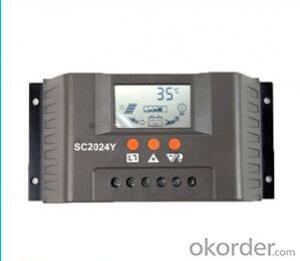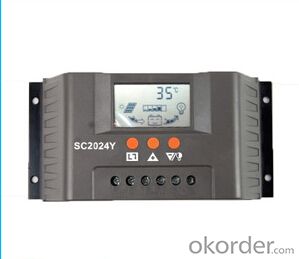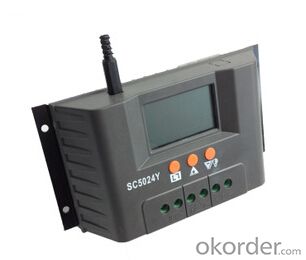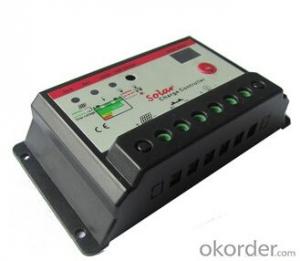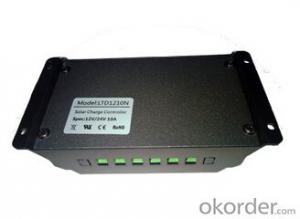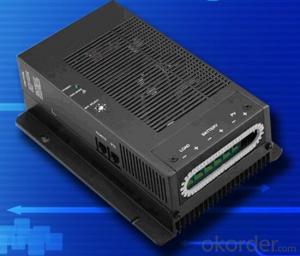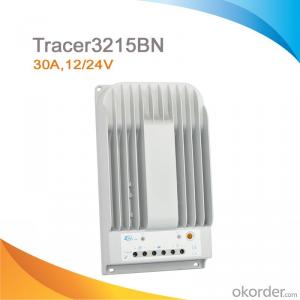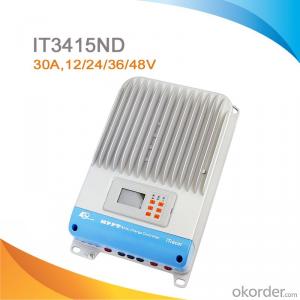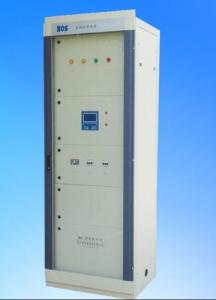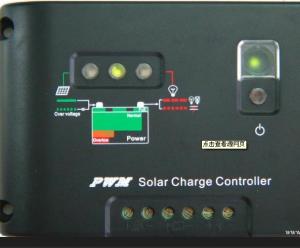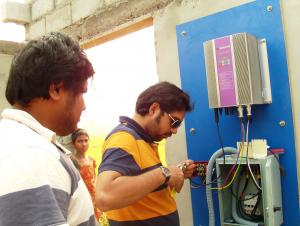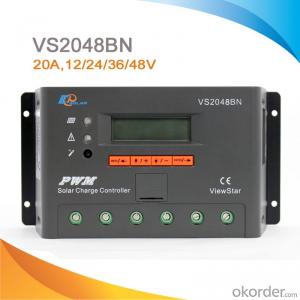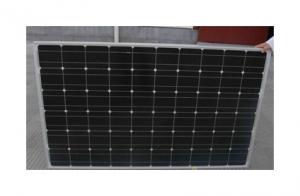12 Volt Solar Charge Controllers bygd intelligent solar controller model sc2024y
- Loading Port:
- Shanghai
- Payment Terms:
- TT OR LC
- Min Order Qty:
- 5 unit
- Supply Capability:
- 50 unit/month
OKorder Service Pledge
OKorder Financial Service
You Might Also Like
Specifications
Main characteristic: 20A PWM 12/24v solar panel charger,solar charge controller with LED
Specification:
Rated Voltage :12V/24V
Rated Load Current :<40a
Over Charge Current :13.7V
Over Discharge Current :10.5-11V
Light control: yes
Temperature control: yes
Time control: yes
Our solar controllers are designed for solar home system, ideal for rural electrification systems,and many advantages compared to other controllers:
Low Cost---
Solar controller has specifically designed to meet the needs of the rural electrification market. The low cost resulted from using the latest electronic technology and high volume manufacturing.
High Reliability--
We are manufacturer of solar charge controllers,power inverters,and solar power systems. All our products are designed for high quality and high reliability. The controller has a low failure rate and will last a long time, and got very good feedback from customers until now.
Electronic protections--
The solar controllers are built-in electronic fused that do not require replacements.
Tropicalization--
The solar controlers electronics are protected with moisture-tight coating, minimizing damage from humidity and from nesting insects.
Easy to use--
Solar controller is fully automatic and requires no adjustments or user selections.
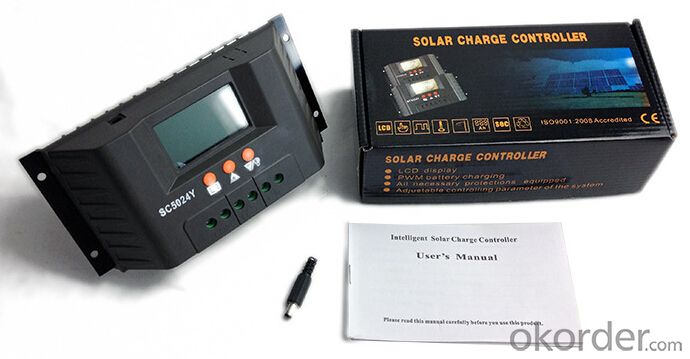
- Q: How does a solar controller handle short-circuit or overload conditions?
- A solar controller is equipped with built-in safety features to handle short-circuit or overload conditions. When a short-circuit occurs, the controller detects the sudden increase in current and immediately shuts off the circuit to prevent any damage. Similarly, in case of an overload condition where the current exceeds the controller's rated capacity, it activates its overload protection mechanism, which can include reducing the charging current or completely disconnecting the load. These protective measures ensure the safe operation of the solar controller and prevent any potential damage to the system.
- Q: Can a solar controller be used with solar panels of different efficiencies?
- Solar panels with different efficiency levels can still be used with a solar controller. The primary function of a solar controller is to regulate the flow of electricity from the panels to the batteries or grid. It is designed to handle varying input voltages and currents from the panels. The efficiency of a solar panel refers to its ability to convert sunlight into electricity. Higher efficiency panels generate more power for a given amount of sunlight. However, the panel's efficiency does not impact its compatibility with a solar controller. As long as the voltage and current of the panels fall within the supported range of the solar controller, they can be used together regardless of their individual efficiencies. The solar controller will manage the charging process and ensure that the batteries or grid receive the optimal amount of power from the panels, regardless of their efficiency.
- Q: Can a solar controller be used with solar panels that are connected to a micro-inverter?
- Yes, a solar controller can be used with solar panels that are connected to a micro-inverter. A solar controller is typically used to regulate or control the charging of batteries in a solar power system. It is responsible for managing the flow of electricity from the solar panels to the batteries, preventing overcharging and ensuring optimal charging efficiency. In a system where solar panels are connected to a micro-inverter, the micro-inverter is responsible for converting the DC power generated by the solar panels into AC power that can be used by household appliances or fed back into the grid. The micro-inverter regulates the output voltage and frequency of the AC power. The solar controller, in this case, can still be used to regulate the charging of batteries in the system. It can monitor the current and voltage of the solar panels and adjust the charging parameters accordingly. The micro-inverter's role is limited to the conversion of power, while the solar controller can still optimize the charging process to ensure the batteries are properly charged and protected. Overall, the combination of a solar controller and a micro-inverter allows for efficient power conversion and optimal battery charging in a solar power system.
- Q: How does a solar controller handle battery temperature compensation for charging?
- A solar controller handles battery temperature compensation for charging by monitoring the temperature of the battery and adjusting the charging voltage accordingly. As the battery temperature rises, the voltage is reduced to prevent overcharging and potential damage to the battery. Similarly, if the battery temperature drops, the voltage is increased to ensure proper charging. This temperature compensation feature helps to optimize the charging process and extend the lifespan of the battery.
- Q: Can a solar controller be used with solar-powered water purification systems?
- Yes, a solar controller can be used with solar-powered water purification systems. A solar controller helps regulate and optimize the charging of batteries in solar systems, ensuring that the batteries are not overcharged or damaged. Since many solar-powered water purification systems rely on batteries to store and supply power, a solar controller is essential in managing the charging process efficiently and effectively.
- Q: How does a solar controller handle battery low voltage recovery?
- The battery low voltage recovery is managed by a solar controller, which constantly monitors the voltage level of the battery bank. When the voltage falls below a specific threshold (typically around 11.5 to 11.8 volts for a 12-volt system), the solar controller commences the recovery process. During this recovery phase, the solar controller eases the burden on the battery bank by disconnecting or reducing power to non-essential loads. This action prevents further depletion of the battery and enables it to recharge more efficiently. In parallel, the solar controller activates the solar panels to initiate the charging of the battery bank. It effectively governs the charging procedure by regulating the amount of current transmitted from the panels to the batteries. By doing so, the controller ensures that the charging current remains within safe boundaries, preventing overcharging and potential damage to the batteries. While the battery voltage gradually increases, the solar controller continuously observes the charging process. Once the battery attains a predetermined voltage level (usually between 13.5 to 14.5 volts for a 12-volt system), the controller switches to a float or maintenance charging mode. In this mode, the controller diminishes the charging current to a lower level, maintaining the battery's full charge while preventing overcharging. To summarize, the solar controller manages the battery low voltage recovery by reducing the load on the battery, activating the solar panels for charging, and overseeing the charging process to restore the battery voltage to a safe and optimal level.
- Q: Can a solar controller be used with solar-powered indoor sports facilities?
- Solar-powered indoor sports facilities can indeed utilize a solar controller. This device serves to regulate the flow of electricity from the solar panels to the battery bank, efficiently charging the batteries and preventing overcharging or undercharging. To harness sunlight and convert it into electricity, solar panels can be installed on the roof or in a nearby location of these facilities. The solar controller will then oversee the charging process, guaranteeing optimal battery charging. Given that indoor sports facilities require a substantial amount of electricity to power various equipment, lighting, and ventilation systems, incorporating solar power allows for reduced reliance on the grid and lower energy costs. Additionally, solar power aligns with sustainability goals and reduces the facility's carbon footprint as it is a clean and renewable energy source. The solar controller will constantly monitor the battery voltage and adjust the charging current to maintain the batteries at their optimal voltage levels. It also protects the batteries by preventing overcharging, which can lead to reduced battery lifespan or damage. Furthermore, the solar controller can offer valuable data and insights regarding the energy production and consumption of the indoor sports facility. This information can be utilized to optimize energy usage, identify areas for improvement, and potentially implement energy-saving measures. To summarize, a solar controller effectively regulates the charging process in solar-powered indoor sports facilities, ensuring optimal battery performance and maximizing the utilization of solar power.
- Q: How do I connect a solar controller to a solar-powered water heater?
- To establish a connection between a solar controller and a solar-powered water heater, a series of steps must be followed: 1. Identification of the solar controller is the first step. This device regulates the energy flow from the solar panels to the water heater. It is typically situated in close proximity to the solar panels and possesses various input and output terminals. 2. The type of solar controller needs to be determined. There are several options available, including PWM (Pulse Width Modulation) and MPPT (Maximum Power Point Tracking). It is important to ensure that the appropriate controller for your system is obtained. 3. The location of the water heater must be determined. The input and output terminals of the water heater are usually labeled as "inlet" and "outlet". 4. The solar panels need to be connected to the input terminals of the solar controller. The manufacturer's instructions should be followed carefully to ensure proper wiring, and it is essential to ensure that the positive and negative terminals are connected correctly. 5. The outlet terminals of the solar controller should be connected to the inlet terminals of the water heater. Once again, the manufacturer's instructions should be consulted for accurate wiring. 6. Configuration of the solar controller may be necessary based on the specific requirements of your system. This may involve the adjustment of temperature limits, flow rates, or other parameters. 7. The system should be tested after the connections and configuration are complete. This is to verify that the system is functioning correctly. Monitoring the water temperature and flow will indicate whether the solar controller is effectively heating the water. Always remember to consult the user manual or seek professional assistance if any step is unclear or if there are any concerns. It is crucial to prioritize safety precautions when working with electrical components.
- Q: Can a solar controller be used with a solar-powered electric scooter charging station?
- A solar-powered electric scooter charging station can utilize a solar controller. This device, also referred to as a charge controller, is specifically designed to regulate the charging process of a solar panel system. Its primary function is to prevent battery overcharging and ensure optimal charging efficiency. When applied to a solar-powered electric scooter charging station, a solar controller effectively manages the energy flow from the solar panels to the batteries that store the energy. By doing so, it helps maintain the battery's health and prolongs its lifespan. Moreover, a solar controller offers valuable data and monitoring capabilities, enabling better management and optimization of the charging station's performance. Therefore, it is highly recommended to incorporate a solar controller into a solar-powered electric scooter charging station to guarantee efficient and dependable operation.
- Q: Can a solar controller handle power surges from the grid?
- No, a solar controller is not designed to handle power surges from the grid. Its main function is to regulate and control the charging of batteries from solar panels. Power surges from the grid are typically handled by surge protectors or other devices specifically designed for that purpose.
Send your message to us
12 Volt Solar Charge Controllers bygd intelligent solar controller model sc2024y
- Loading Port:
- Shanghai
- Payment Terms:
- TT OR LC
- Min Order Qty:
- 5 unit
- Supply Capability:
- 50 unit/month
OKorder Service Pledge
OKorder Financial Service
Similar products
Hot products
Hot Searches
Related keywords
